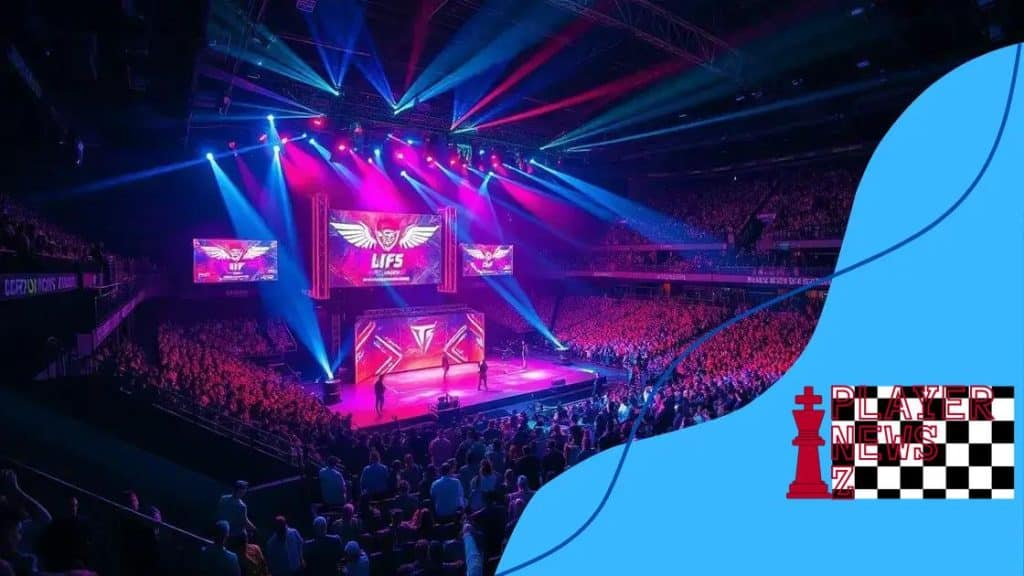The economic impact of e-sports on the global market

The economic impact of e-sports on the global market is significant, as it drives investment, brand engagement, and technological innovation, reshaping entertainment and creating diverse opportunities for stakeholders.
The economic impact of e-sports on the global market is undeniable, transforming not just gaming but entire industries. Have you noticed how brands are diving into this landscape? Let’s explore this phenomenon together.
Understanding the rise of e-sports
As the world becomes increasingly digital, the rise of e-sports has taken the center stage. It’s fascinating to see how competitive gaming has grown into a multi-billion dollar industry.
The surge in e-sports can be attributed to various factors. Players and fans alike are drawn into this immersive experience. Platforms like Twitch allow viewers to watch live gameplay, adding an engaging layer to the experience. Not only are these events entertaining, but they also create communities that share a love for gaming.
Factors Contributing to the Rise
There are several reasons behind the rapid growth of e-sports:
- The increase in internet accessibility
- Advancements in technology and gaming graphics
- Social media and streaming platforms fostering a fan base
Moreover, the support from both amateur and professional leagues has made e-sports more competitive and appealing. Gamers can now aim for careers in this field, attracting many young talents. Major gaming tournaments, with substantial prize pools, draw in countless participants and viewers worldwide, showcasing exciting talent and skills.
The Cultural Shift
This rise also signals a broader cultural shift. E-sports has transformed how we view sports and entertainment. Traditional barriers are breaking down, allowing gamers to be celebrated much like traditional athletes. This has led to an acceptance of gaming as a legitimate career path, providing new opportunities not just for players but also for content creators, analysts, and coaches.
Ultimately, understanding the rise of e-sports involves recognizing its multifaceted nature. It’s not just about playing games; it’s about building a community, fostering creativity, and establishing a new frontier in entertainment.
Economic opportunities within e-sports
The growth of e-sports has opened numerous economic opportunities for various stakeholders. From players to brands, this industry offers a landscape teeming with potential.
One major avenue is seen in sponsorships. Brands are increasingly recognizing the value of advertising through e-sports. By sponsoring teams or events, companies can connect with a young, enthusiastic audience that is deeply engaged. This leads to profitable partnerships and marketing strategies that reach millions.
Revenue Streams in E-sports
The economic opportunities within e-sports extend to multiple revenue streams:
- Advertising and Sponsorships: Companies invest in teams, tournaments, and platforms to increase brand visibility.
- Merchandising: Sales of team jerseys, gaming peripherals, and collectibles contribute to team revenues.
- Prize Pools: Major tournaments offer substantial financial rewards, attracting top talent.
Moreover, streaming platforms further enhance e-sports monetization. Gamers can broadcast their gameplay live on platforms like Twitch, earning revenue through subscriptions and donations from fans. This has created a new career path and income source for many players. Additionally, tournaments are now streamed globally, allowing fans to engage from anywhere.
Careers in E-sports
The opportunities in e-sports are not limited to players. Behind every successful team are managers, marketing personnel, coaches, and analysts working tirelessly to support their athletes. This growing ecosystem means more jobs in fields that didn’t exist a decade ago.
With universities offering scholarships and degrees in e-sports management, the industry is becoming more professionalized, allowing individuals to pursue this passion as a viable career. As e-sports continues to expand, the economic landscape will evolve, presenting even more opportunities for those willing to explore them.
Impact of e-sports on traditional sports

The impact of e-sports on traditional sports is a fascinating topic that has gained attention in recent years. As e-sports grow, they influence traditional sports in unexpected ways, changing how fans engage with both.
One major effect is the blending of audiences. Fans of traditional sports are increasingly becoming interested in e-sports. While watching a football game, they might also tune in to a League of Legends tournament, expanding their entertainment options. This crossover showcases how e-sports attract diverse demographics, including younger viewers who may not be as engaged with conventional sports.
Changing Fan Engagement
Another significant change is how fans engage with sports. Traditional sports are adopting elements from e-sports to reach new audiences. For instance, teams use social media and streaming platforms to connect with fans. They host watch parties and live events where fans can interact in real-time. This creates a more immersive experience, bringing communities together.
- Interactive Experiences: Fans can engage directly through chats and polls during games.
- Fantasy Leagues: Combining elements of gaming and sports, they enhance the excitement.
- Merchandise Collaborations: Teams are launching products that blend elements from both industries.
Moreover, traditional sports leagues are starting to invest in e-sports. Organizations like the NBA and FIFA have launched their own gaming leagues. This strategy not only diversifies their revenue but also captures the growing interest in competitive gaming. By aligning themselves with this trend, traditional sports walk a fine line, adapting while retaining their essence.
Opportunities for Collaboration
As these two worlds intersect, opportunities for collaboration arise. Event organizers can create tournaments that highlight both e-sports and traditional sports, attracting a wider audience. Additionally, training regimens for athletes may start to incorporate gaming skills, acknowledging the mental agility required in both disciplines.
In time, the relationship between e-sports and traditional sports will only deepen, blending cultures and redefining entertainment. It will be intriguing to watch how these influences continue to shape the future of sports as a whole.
The role of brands in e-sports growth
The role of brands in e-sports growth is crucial. As this industry expands, companies are recognizing the potential to connect with a diverse audience.
Brands are increasingly investing in e-sports because it offers a unique way to engage with fans. From sponsorship deals to partnerships, brands can amplify their visibility through strategically aligning with players and events. This connection fosters a deep relationship between the brand and the consumer.
Forms of Brand Engagement
There are several key ways brands engage with the e-sports community:
- Sponsorships: Companies sponsor teams and tournaments, providing financial support in exchange for advertising.
- Influencer Marketing: Collaborating with popular streamers and players helps brands reach their target audiences.
- Product Placement: Brands integrate their products into the gameplay or livestreams, creating a seamless connection with viewers.
Moreover, the interactive nature of e-sports allows brands to experiment with new marketing strategies. Live events and tournaments provide platforms for brands to launch campaigns that engage fans directly. For example, offering merchandise or limited-time promotions during significant tournaments can drive sales and enhance brand loyalty.
Building Community and Loyalty
Importantly, brands that actively participate in the e-sports scene build a sense of community. This is achieved by sponsoring local events, supporting grassroots initiatives, and engaging in conversations on social media. By doing so, they move beyond traditional advertising and become part of the culture.
This connection increases brand loyalty. Fans are more likely to support brands that champion their favorite players or teams. As e-sports continues to grow, brands that embrace this dynamic will find themselves positioned at the forefront of an evolving market.
Future trends in the e-sports market
The future trends in the e-sports market are evolving rapidly as technology and gaming cultures intersect. This evolution is shaping how fans engage with their favorite games and players. Understanding these trends can help stakeholders prepare and adapt their strategies.
One major trend is the rise of virtual reality (VR) and augmented reality (AR) in e-sports. As these technologies improve, they offer immersive experiences for players and audiences. Imagine watching a tournament in a fully interactive environment where fans can feel as if they are part of the action. This could change how we experience competitive gaming.
Increased Investment in Infrastructure
Another trend is the growing investment in e-sports infrastructure. More companies are recognizing the necessity of establishing arenas and dedicated spaces for tournaments. This investment will support larger events and provide better production quality for broadcasts.
- Stadiums: New venues designed for e-sports are opening globally.
- Streaming Platforms: Enhanced features on platforms allow for better interaction between streamers and viewers.
- Improved Connectivity: Faster internet and lower latency are crucial for competitive play.
Furthermore, we are seeing a surge in collegiate e-sports. Universities are establishing teams and offering scholarships, making e-sports a career path for many young players. This not only diversifies the talent pool but also promotes e-sports in academic settings.
Sustainability in E-sports
Another significant trend is sustainability. As the industry grows, there is a push for more eco-friendly practices. This includes using energy-efficient technology, reducing waste during events, and promoting sustainability messages. Fans increasingly value brands that support environmentally friendly initiatives, impacting purchasing decisions.
As we explore the future trends in the e-sports market, it is evident that creativity and innovation play critical roles. Stakeholders must adapt to shifting preferences to stay relevant in this dynamic landscape. The combination of technology, infrastructure investment, and a focus on sustainability will undoubtedly shape a bright future for e-sports.
FAQ – Frequently Asked Questions About E-sports Growth
How are brands contributing to the growth of e-sports?
Brands are investing in sponsorships and collaborations, engaging fans and enhancing their visibility in the e-sports community.
What technological innovations are impacting e-sports?
Technologies like virtual reality (VR) and augmented reality (AR) are creating immersive experiences for audiences and players alike.
What role does community play in the e-sports ecosystem?
The e-sports community is expanding, fostering a sense of belonging and encouraging more participation from fans and players.
Why is sustainability important in the e-sports market?
Sustainability is crucial as the industry grows, with a focus on eco-friendly practices enhancing brand reputation and attracting environmentally conscious fans.





